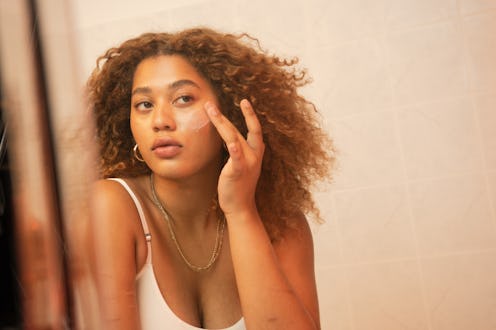(Beauty)
The Acne-Fighting Ingredient You Haven’t Tried Yet — & Why It Works So Well

If you’ve tried all the typical acne fighting ingredients — salicylic acid, benzoyl peroxide, and even retinol — and haven’t seen results, it might be time to try tretinoin, a powerful acne-fighting ingredient that dermatologists love. A derivative of vitamin A, the main ingredient in both the controversial acne treatment Accutane and popular retinol creams, tretinoin is a prescription-strength topical that has previously only been available via a trip to the dermatologist. However, the recently launched women’s healthcare platform Hers is here to change that.
Launched in early November, Hers aims to connect women to a “network of over 150 doctors and products that are up to 80 percent off traditional retail,” the brand tells The Zoe Report; across the areas of sexual wellness, hair care, and, yes, skincare. One of those products includes The Acne Treatment, a combination of a morning cream and a night cream infused with tretinoin to give adult acne the one-two punch.
“Tretinoin is widely used in dermatology for a variety of indications ranging from acne to anti-aging,” Sara Perkins, M.D., a dermatologist and advisor to Hers, tells The Zoe Report. “It decreases the size of your pores and increases cell turnover within them, which re-trains your skin and prevents pores from getting clogged. It also stimulates collagen production and has been shown to improve the appearance of fine lines and wrinkles, as well as dyspigmentation.”
But even Perkins admits that the ingredient can be tricky. As with any acne treatment that promises too-good-to-be-true results, it comes with a word of caution. “The major side effect is irritation, which may include redness, scaling, dryness, itchiness, stinging, and burning,” Aanand Geria, M.D. of Geria Dermatology tells TZR. “Consumers may also experience increased sensitivity to sunlight.” And, just like with prescription retinol creams, acne may actually get worse before it gets better.
“Don’t expect results for six to eight weeks,” Dr. Perkins warns. “But they're worth the wait.”
If you’re willing to wade through weeks of sensitivity and inflammation, there are compelling benefits awaiting you on the other side — like the aforementioned clear skin, even tone, and fewer fine lines. But due to the potential dangers involved, it’s necessary to get a dermatologist prescription before you can get your hands on the treatment. “Consultation with a physician prior to treatment is important to ensure that you start the best regimen for your specific skin type and needs,” Dr. Perkins says. “But Hers makes it easy for women to connect with a doctor and receive the proper skin treatment for them, all at an affordable price point.”
It’s true: Anyone can hop over to the Hers website, click “add to cart” on a $44 tretinoin regimen and set up an online consultation with a Hers-recommended doctor. The doctor will assess your skin, determine if tretinoin is a good fit, and walk you through usage instructions if it is. Usage will be different for each patient, but there are some universal suggestions: don’t layer on other skincare products until 20 minutes after applying; avoid laser treatments, facial waxing, and chemical peels; and check with your doctor before mixing tretinoin with other acne-fighting skincare ingredients.
According to the women’s wellness company, this is the future of skincare — its site even boasts the question, “If it's not prescription, how do you know you’re not just applying marketing?” in inch-high letters. Which, admittedly, is a bit of a flawed concept: The $1.2 trillion dollar pharmaceutical industry utilizes marketing, too. (What other way is there to convince customers to trust a treatment that involves eight weeks of itching, peeling, worse-before-it’s-better skin?)
Luckily, Hers’ Acne Treatment set has been strategically designed to address the concerns associated with tretinoin. The AM Cream is free of the ingredient and meant to be used every morning; and is packed with moisturizing ingredients like clindamycin phosphate and squalene to keep skin ultra-hydrated. The PM Cream is the first of its kind: It marries tretinoin with niacinamide, the latter of which builds up the skin’s barrier and has been shown to improve the results of tretinoin, in a formula that intends to stop side effects before they start.
“People with dry, sensitive skin or those who suffer from eczema or rosacea are more likely to experience irritation,” Dr. Geria notes. “But nonetheless, even these skin types can eventually tolerate tretinoin.” He suggests starting gradually by applying it only a few times a week and working your way up to a nightly routine.
It’s worth noting that not all dermatologists are fans of the treatment, though. “Topical brighteners like tretinoin can make the skin light sensitive, potentially worsening dark spots and redness,” Loretta Ciraldo, M.D., a Miami-based board certified dermatologist (who was amongst the first to study the effects of UVA radiation on skin at Harvard's photobiology lab in the 1970s), tells The Zoe Report; suggesting that thanks to “user error” — getting too much sun exposure while on it — the treatment might actually do more harm than good.
Obviously, adding a super-strength ingredient like tretinoin to your routine is a decision that needs to be taken seriously and made under the advisory of a derm… but thanks to Hers, who says you can't talk over the pros and cons from the comfort of your own home (in the comfort of your sweatpants)?